VISUAL ETHNOGRAPHY: MY LONDON EXPERIENCE
INTRODUCTION
The use of video and photography in the field of ethnography continues to expand as world has grown to become more visual both in observation and communication of knowledge. Pink point out that, “the benefits of ethnographic approach are being realized in visual arts and media studies” ( Sarah Pink, Doing Visual Ethnography, 1). Through the reading of Pink’s books and the London advance, I have developed a new appreciation for ethnography. Drawing on the knowledge grain from reading, I have attempted to recount my London experience using the methods of ethnography.
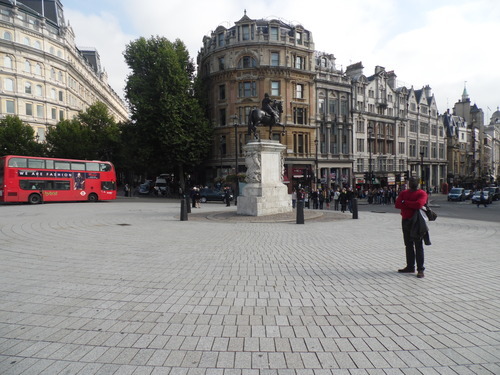
INTEREST
The London advance was my first (hopeful not my last) trip to London. Not sure what my expectations of London were before the trip but I am certain they were all exceeded. The one things I was certain of coming to London was that, I needed to be extra observant for the ethnography assignment. Just as London was going to be a new experience, ethnography as a science was also new to me. Before reading Sarah Pink’s books, I had no knowledge of the science. Now I realized that everyone practices ethnography at some level.
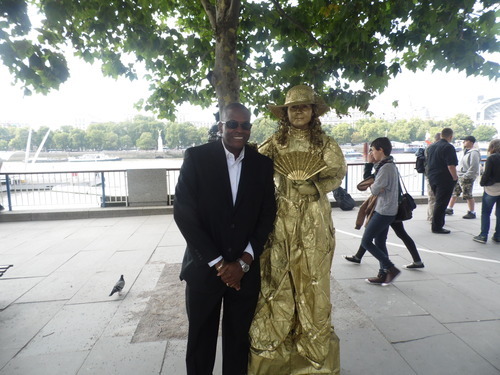
As I reflected on what sparked on what sparked on held my interest during the London adventure, I settled on the top two things. The first was the city of London itself. Growing up in the British West Indies at a time when the influence of England was still very strong on the islands, one had a deep respect and admiration for England. Growing up in the islands you either had respect or hatred for England. This was especially so because of the historical and educational influence mother country had over the islands. The educational systems were all base on a British model, which meant that most of what was taught, was taught from a British perspective. Even the study of West Indian history was done on a British narrative. This meant also that, most of what we learnt had a British foundation or origin. For example, the study of economic, you learnt about John Smith and the small shops of London.
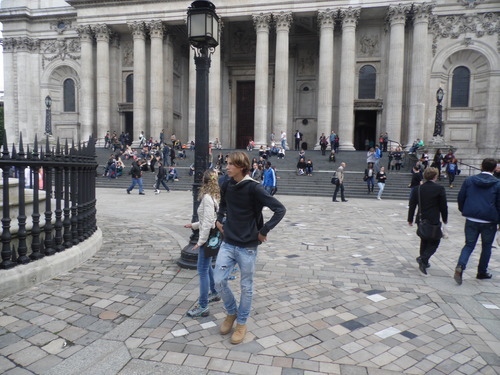
Being one who loves to explore new places and study history, London was amazing for me. I got the opportunity to connect with a part of my history that was not possible before the advance. Especially, the visit to Lloyds of London, to see the River Thames, Big Ben, Buckingham Palace, St. Paul’s Cathedral, Westminster Abbey, 10 Downing Street and the other historical places I was able to visit. I hope to do it again sometime in the future. Judging from the crowds I witnessed on my brief exploration around London, I know that it is a city that attracts a great number of people with the same interest as I. Apart from the historical interest I found in London, I was also impressed with London as a city. It is much bigger than I thought, very cosmopolitan, and the subway system is impressive. These were all new discoveries for me.

The second thing that most sparked my interest in London, was the re-igniting of my vision. In the 1990‘s while pastoring in the Caribbean, I developed a deep passion for leadership development training. This drove me to the United States to pursue further studies as a way of better equipping myself. My intention was to study and then return to the Caribbean to resume pastoring and leadership development training. My plans did not go as well as I thought they would and years after I am still in the United States. I was able to complete studies at the undergraduate and graduate levels but desired to go further. George Fox provided that opportunity to do so. 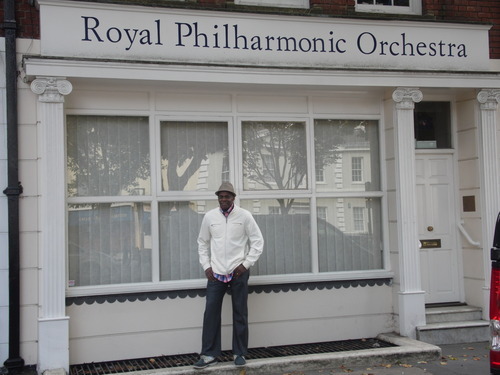
The whole experience brought the reading of Grenz and Olson from their book “Who Needs Theology,” into focus. They asked “Who need theology?” and concluded that everyone needs theology.
“The Christian church and individual Christians who seek to grow in their faith need lay, ministerial and professional theology” ( Grenz and Olson, Who Needs Theology, 1996, Kindle Version Loc. 288). I share this conviction with the authors and London made this even clearer. With the emerging issues in postmodern culture that are challenging long held Christian beliefs, the need for theological clarity and become more urgent. This need is a major motivating factor in my desire to complete this program.
During the global conference on the Saturday, the presentations of Dr. Faith and Kris touched on topics that are very dear to my heart. I felt my passions being rekindled with sense of urgency. This was further fueled by the call of David Ford for “churches and other faith communities to develop high-quality studies and discussions of issues relevant to them” (Ford, Theology: A Very Short Introduction, 2000, Kindle Version Loc. 514-515) The presentations mentioned above provided insights on how one may help the church engage in the discussion of relevant issues. Beside the conference demonstrated the need to be knowledgeable on the issues. Ford also sees the need for church and religious communities, “to have members and others who are well educated and theological literate” ( Ford, Loc. 515). As mentioned earlier, seeing this need is what brought me to the United States and why I am enrolled in this program.

WHAT HAVE I ATTEMPTED
Since returning from the advance and resuming my busy schedule, I have not been able to be as purposeful as I would like with doing ethnography. Though I have been attempting some new things on the job, at church, and even in my personal life, I would like to be more purposeful. At the church I am seeking to ensure that more moments are captured on photo and turned into memories. A close friend of the ministry has been encouraging me for sometime now, to chronicle more of the ministry’s development by capturing more on photo. I never saw the importance of dong this until my trip to London. Now we are doing just that, though on a small scale at the moment, this will be expanding as the ministry grows.
Sarah Pink points out the growing importance of photography in contemporary ethnography.
“Photography can inspire people to represent and then articulate embodied and material experiences that they do not usually recall in verbal interviewing” (Sarah Pink, Doing Visual Ethnography 2012, p28). This also illustrate what Pink refers to when she spoke about the usefulness of photography providing data that help in understanding how people experience their social and material environments.
We have started discussions on the use of video recording to capture the entire Sunday worship service. Again, this is to be more inline with the visual culture that Pink talk about moving toward the capturing of moments that can be reviewed and reflected on, in a way that is not possible without the use of these modern tools. As a result my interest in the use of ethnography continues to grow beyond usages in the church. Our church is close to a college and a number of high schools. We see an opportunity for us to develop a better understanding of the current youth culture by conducting interviews using video cameras to record. The objective to develop a clearer understanding of how these young people think and their knowledge of spiritual reality. Then these videos will be used in the training of youths with the church for campus evangelism. London opened my eyes to the need of becoming more creative in advancement of the Kingdom.
Video can be used to past on information as well as educate. Recently we used a video called “Transformation”, that documented what God is doing around the world through united prayer, as a tool to inspire our church to become more committed to prayer. We also used a video that documented the presentation of Christian in Nigeria by the radical Muslim group Boka Rahran. This provided an opportunity for our members not only to be informed but to also to put a face to what they having hearing on the news.
For the young college and high school adults, the goal is to go on campus and conduct one on one interviews. These interviews are designed to be fact findings, helping us to be better understand the cultural mindset and what approach the ministry needs to develop in an attempt to effectively reach these young adults with the gospel. By video taping. By video taping these interviews we will able to better study these individuals. We would the opportunity to recall play the interviews, study the body language, and feel the convictions of the interviewers.
Pink has helped me to understand that ministry can be more effective if one is willing to invest in gaining a better understanding of the people we are attempting to reach. This is something that the church has not done very well and I can say that in my 30 plus years of church and ministry involvement, I have been a part of ministry that has attempted to better understand a community they were attempting to reach. I have read about churches such as Willow Creek and others who have done so, with remarkable success. This shows that there are some positive values, in such undertakings.
WHAT HAS STAYED WITH ME
A number of things made impressions on me that have remained. First, the use of social media and new tools of communication. Before coming to George Fox, I cared very little about social media. To me it was too much time wasting and counter productive for my personal life style. Since the advance I have grown to appreciate some of the social media tools that are being used in this program. I am able to see the value of social media in keeping people connected even meeting new people. It can also be a powerful tool in the spreading of the gospel and the advancing of the Kingdom. Millions of people interact on social media each day, especially young people. This has created a new field for the proclamation of the gospel. I have heard of churches having special trained teams that work in this arena. This is something I would have love to explore further.
Second, while in London I attended a Church at Hillsong Church; the experience was life transforming. The service started at 11am, we arrived around 10:15 and a number of people were already gathering on the outside of the building. The doors to the building were not yet opened but the crowd kept increasing and people begun to mingled with each other. Though we were visiting for the first time, at no point were we made to feel like strangers. People just kept coming up to us and initiating conversation. We got to meet a number of people from all over the world. At one point one of my companions turn and asked, “Do you see how many people have come and spoken to us? This tells you a lot about the church.”
The church doors eventually opened and again, I saw something I had not seen before. The sanctuary was still closed. People were congregating in the foyer having coffee and fellowship, it was a sight to behold. At first we were wondering why they were not allowing anyone into the sanctuary. Then we realized that it was done on purpose, providing the opportunity for people to fellowship and build relationship. Since this was my first time seeing a church operate like this, I was intrigued by what I was witnessing. I know that there are churches in the United States that provide coffee and donuts in the fellowship hall before their services. What made this special were the number people who gathered early and were engaged in such high level of fellowship and interactions in. In the United States one can go to church a stranger and leave as one; not at this church.
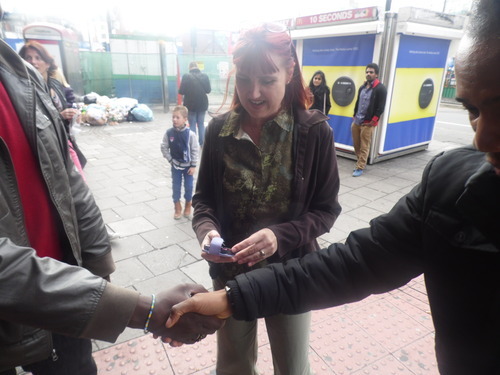
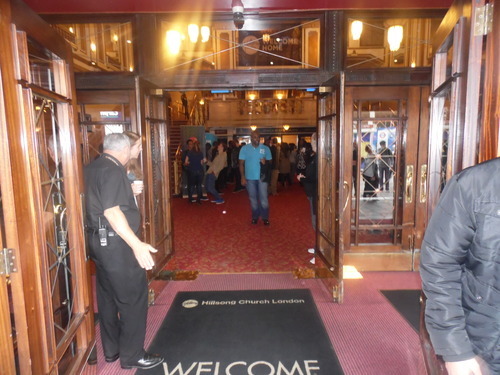
Once the sanctuary was opened and people started assembling, the fellowship continued. Everyone who sat in proximity to us on the same row, the row immediately front, as well as the row behind us, shook our hands and introduced themselves to us. They asked our names, how long we were attending the church or if we were visitors. This was a truly unique experience.
The worship experience was also unique. The church meets in a theater and uses the ambiances of the theater with stunning effects in its worship. The moving lights which at times, almost appear distracting is what makes this worship experience unique. With the large crowds that were in attendance, one can see the results. What I saw here is a church evolving to reach a community that is itself, experience changes and growth on several levels. The history of church as documented by Alister McGrath has been a history of evolving and transforming communities. McGrath’s book, Christian Theology, is a masterpiece which serve to help the modern church understand how we got to where we are today. I developed a deep appreciation for this because of the historical perspectives it provides. These help us to see the church at its best as well at its worst. It also help us to see how the church navigated through the cultural, social and spiritual issues of its day, being relevant yet, theologically authentic.
What I experienced at Hillsong would have been condemned as worldly in the nineteen eighties when I became a Christian. Hillsong is pioneering a spiritual revolution through its music and its culturally relevant style of worship that is impacting lives of a large number of young people. The church is able to do this without compromising the authenticity of gospel. Reading McGrath reveals that this is an approach that has always aided the growth of the church.
Finally, the overall experience of London, it’s people, and culture. I love the richness of the culture. Just walking around London one can easily sense the richness of the culture of the British people. I had the opportunity to visit Piccadilly Circus at night where it seems like the true spirit of London lives. The people in street, the theaters, the lights all make this a special place. Subway, was another pleasurable experience in London. I was impressed by how extensive the network is, its cleanness, and efficiently. I have had the opportunity to ride Subways in New York and Toronto and London’s’ is much more ordered, the stations for the most part are more beautiful. I did not see any trash or felt unsecured for one moment. Unlike my New York experience where I witnessed arguments almost to the point of fights. Trash thrown all over the station, and unfriendly people, who made you felt uncomfortable. I came from London, feeling it is truly of one the world’s great cities. For more extensive then I thought as well as entertaining. I am looking forward to returning to London soon with my family to explore the city a bit more Would like to tour Buckingham Palace and some of the other historical sites I was not able to see on this trip.
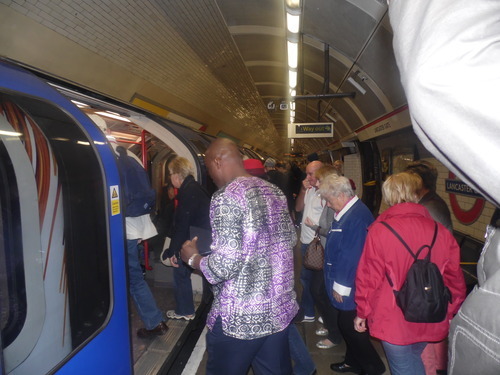
CONCLUSION
There is a popular saying which states that, “a picture is worth a thousand words” (author unknown). The tools of visual ethnography have assisted me in capturing many of these valuable pictures while in London. By applying the use of video, photography, and visual observation, I have a store of memory that have aided both my knowledge and my appreciation for the people and culture of London. I have documented in this paper, some of my interests, and the ways in which the learning experience has changed my attitude to visual ethnography.
1. Ford, David F. Theology: A Very Short Introduction. New York: Oxford University Press, 2000.
2. Grenz, Stanley J., and Roger E Olson. Who Needs Theology? An Invitation To The Study of God. Downers Grove: InterVarsity Press, 1996.
3. McGrath, Alister. Christian Theology: An Introduction. 5th ed. London: Blackwell Publishing Ltd. , 2011.
4. Pink, Sarah. Doing Visual Ethnography. 2nd ed. London: Sage, 2007.
5. Pink, Sarah. Doing Sensory Ethnography. London: Sage, 2009.
Leave a Reply
You must be logged in to post a comment.